- Clone
- HCD54 (See other available formats)
- Regulatory Status
- RUO
- Other Names
- ICAM-1, Ly-47
- Isotype
- Mouse IgG1, κ
- Ave. Rating
- Submit a Review
- Product Citations
- publications
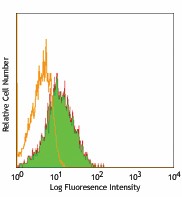
-

Human peripheral blood lymphocytes stained with Ultra-LEAF™ purified HCD54, followed by anti-mouse IgG FITC -

MDA-MB231 breast cancer cell line was stained with anti-human CD54, detected with anti-mouse DyLight™ 649, and nuclear counterstained with DAPI. Images were acquired with a TE300 fluorescence microscope with a 20x objective. Data provided by: Er Liu and John Nolan, La Jolla Bioengineering Institute
| Cat # | Size | Price | Quantity Check Availability | Save | ||
|---|---|---|---|---|---|---|
| 322721 | 100 µg | 150€ | ||||
| 322722 | 1 mg | 542€ | ||||
CD54 is a 85-110 kD type I transmembrane protein also known as ICAM-1. It is expressed on activated endothelial cells, high endothelial venules, T and B cells, monocytes/macrophages, granulocytes, and dendritic cells. The expression of ICAM-1 on the cell surface is potently upregulated by activation; a soluble form of ICAM-1 can be released from the cell surface. CD54 plays a role in cellular adhesion and is involved in inflammation and leukocyte extravasation. CD54 has also been shown to be the major cellular receptor for rhinovirus. ICAM-1 binds to CD11a/CD18 (LFA-1), CD11b/CD18 (Mac-1), CD11c/CD18 (p150, 95) as well as hyaluronan and fibrinogen.
Product DetailsProduct Details
- Verified Reactivity
- Human
- Reported Reactivity
- Chimpanzee
- Antibody Type
- Monoclonal
- Host Species
- Mouse
- Formulation
- 0.2 µm filtered in phosphate-buffered solution, pH 7.2, containing no preservative.
- Endotoxin Level
- Less than 0.01 EU/µg of the protein (< 0.001 ng/µg of the protein) as determined by the LAL test.
- Preparation
- The Ultra-LEAF™ (Low Endotoxin, Azide-Free) antibody was purified by affinity chromatography.
- Concentration
- The antibody is bottled at the concentration indicated on the vial, typically between 2 mg/mL and 3 mg/mL. Older lots may have also been bottled at 1 mg/mL. To obtain lot-specific concentration and expiration, please enter the lot number in our Certificate of Analysis online tool.
- Storage & Handling
- The antibody solution should be stored undiluted between 2°C and 8°C. This Ultra-LEAF™ solution contains no preservative; handle under aseptic conditions.
- Application
-
FC - Quality tested
ICC - Verified
Block - Reported in the literature, not verified in house - Recommended Usage
-
Each lot of this antibody is quality control tested by immunofluorescent staining with flow cytometric analysis. For flow cytometric staining, the suggested use of this reagent is ≤ 2.0 µg per million cells in 100 µL volume. It is recommended that the reagent be titrated for optimal performance for each application.
- Application Notes
-
Additional reported applications (for the relevant formats) include: in vitro blocking of lymphoctes interaction1. The Ultra-LEAF™ purified antibody (Endotoxin <0.01 EU/µg, Azide-Free, 0.2 µm filtered) is recommended for functional assays (Cat. No. 322721 & 322722).
- Application References
-
- Evans HG, et al. 2009. Proc. Natl. Acad. Sci. USA. 106:6232. (Block) PubMed
- Product Citations
-
- RRID
-
AB_2832632 (BioLegend Cat. No. 322721)
AB_2832633 (BioLegend Cat. No. 322722)
Antigen Details
- Structure
- Type I membrane protein, Ig superfamily, 85-110 kD
- Distribution
-
Activated endothelial cells, high endothelial venules, T cells and B cells, monocytes/macrophages, granulocytes, dendritic cells. Cell surface expression upregulated upon activation; soluble ICAM-1 released from surface.
- Function
- Cellular adhesion, involved in inflammation and immune reactions. CD54 expressed on endothelial cells in areas of inflammation plays a role in leukocyte extravasation. Major cellular receptor for rhinovirus.
- Ligand/Receptor
- CD11a/CD18 (LFA-1), CD11b/CD18 (Mac-1), CD11c/CD18 (p150, 95) and has also been reported to bind hyaluronan and fibrinogen
- Cell Type
- B cells, Dendritic cells, Endothelial cells, Granulocytes, Macrophages, Mesenchymal Stem Cells, Monocytes, T cells
- Biology Area
- Cell Biology, Costimulatory Molecules, Immunology, Innate Immunity, Neuroscience, Neuroscience Cell Markers, Stem Cells
- Molecular Family
- Adhesion Molecules, CD Molecules
- Antigen References
-
1. Voraberger G, et al.. 1991 J. Immunol. 147:2777.
2. Staunton DE, et al.. 1988. Cell 52:925.
3. Greve JM, et al.. 1989. Cell 56:839. - Gene ID
- 3383 View all products for this Gene ID
- UniProt
- View information about CD54 on UniProt.org
Related FAQs
- Do you guarantee that your antibodies are totally pathogen free?
-
BioLegend does not test for pathogens in-house aside from the GoInVivo™ product line. However, upon request, this can be tested on a custom basis with an outside, independent laboratory.
- Does BioLegend test each Ultra-LEAF™ antibody by functional assay?
-
No, BioLegend does not test Ultra-LEAF™ antibodies by functional assays unless otherwise indicated. Due to the possible complexities and variations of uses of biofunctional antibodies in different assays and because of the large product portfolio, BioLegend does not currently perform functional assays as a routine QC for the antibodies. However, we do provide references in which the antibodies were used for functional assays and we do perform QC to verify the specificity and quality of the antibody based on our strict specification criteria.
- Does BioLegend test each Ultra-LEAF™ antibody for potential pathogens?
-
No, BioLegend does not test for pathogens in-house unless otherwise indicated. However, we can recommend an outside vendor to perform this testing as needed.
- Have you tested this Ultra-LEAF™ antibody for in vivo or in vitro applications?
-
We don't test our antibodies for in vivo or in vitro applications unless otherwise indicated. Depending on the product, the TDS may describe literature supporting usage of a particular product for bioassay. It may be best to further consult the literature to find clone specific information.
Other Formats
View All CD54 Reagents Request Custom Conjugation| Description | Clone | Applications |
|---|---|---|
| Purified anti-human CD54 | HCD54 | FC,ICC,Block |
| Biotin anti-human CD54 | HCD54 | FC |
| PE anti-human CD54 | HCD54 | FC |
| Alexa Fluor® 488 anti-human CD54 | HCD54 | FC |
| APC anti-human CD54 | HCD54 | FC |
| Pacific Blue™ anti-human CD54 | HCD54 | FC |
| Alexa Fluor® 647 anti-human CD54 | HCD54 | FC |
| FITC anti-human CD54 | HCD54 | FC |
| Ultra-LEAF™ Purified anti-human CD54 | HCD54 | FC,ICC,Block |
Customers Also Purchased
Compare Data Across All Formats
This data display is provided for general comparisons between formats.
Your actual data may vary due to variations in samples, target cells, instruments and their settings, staining conditions, and other factors.
If you need assistance with selecting the best format contact our expert technical support team.
-
Purified anti-human CD54
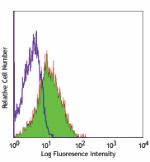
Human peripheral blood lymphocytes stained with purified HCD... 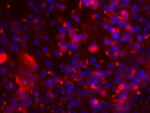
MDA-MB231 breast cancer cell line was stained with anti-huma... -
Biotin anti-human CD54
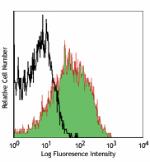
Human peripheral blood lymphocytes stained with biotinylated... -
PE anti-human CD54
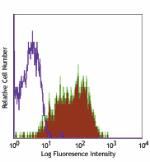
Human peripheral blood lymphocytes stained with HCD54 PE -
Alexa Fluor® 488 anti-human CD54
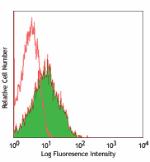
Human peripheral blood lymphocytes stained with HCD54 Alexa ... -
APC anti-human CD54

Human peripheral blood lymphocytes stained with HCD54 APC -
Pacific Blue™ anti-human CD54

Human peripheral blood lymphocytes were stained with CD54 (c... -
Alexa Fluor® 647 anti-human CD54

Human peripheral blood lymphocytes stained with HCD54 Alexa ... -
FITC anti-human CD54
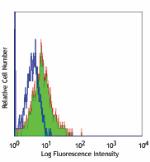
Human peripheral blood lymphocytes stained with HCD54 FITC. -
Ultra-LEAF™ Purified anti-human CD54
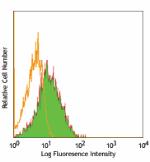
Human peripheral blood lymphocytes stained with Ultra-LEAF™ ... 
MDA-MB231 breast cancer cell line was stained with anti-huma...
 Login / Register
Login / Register 












Follow Us